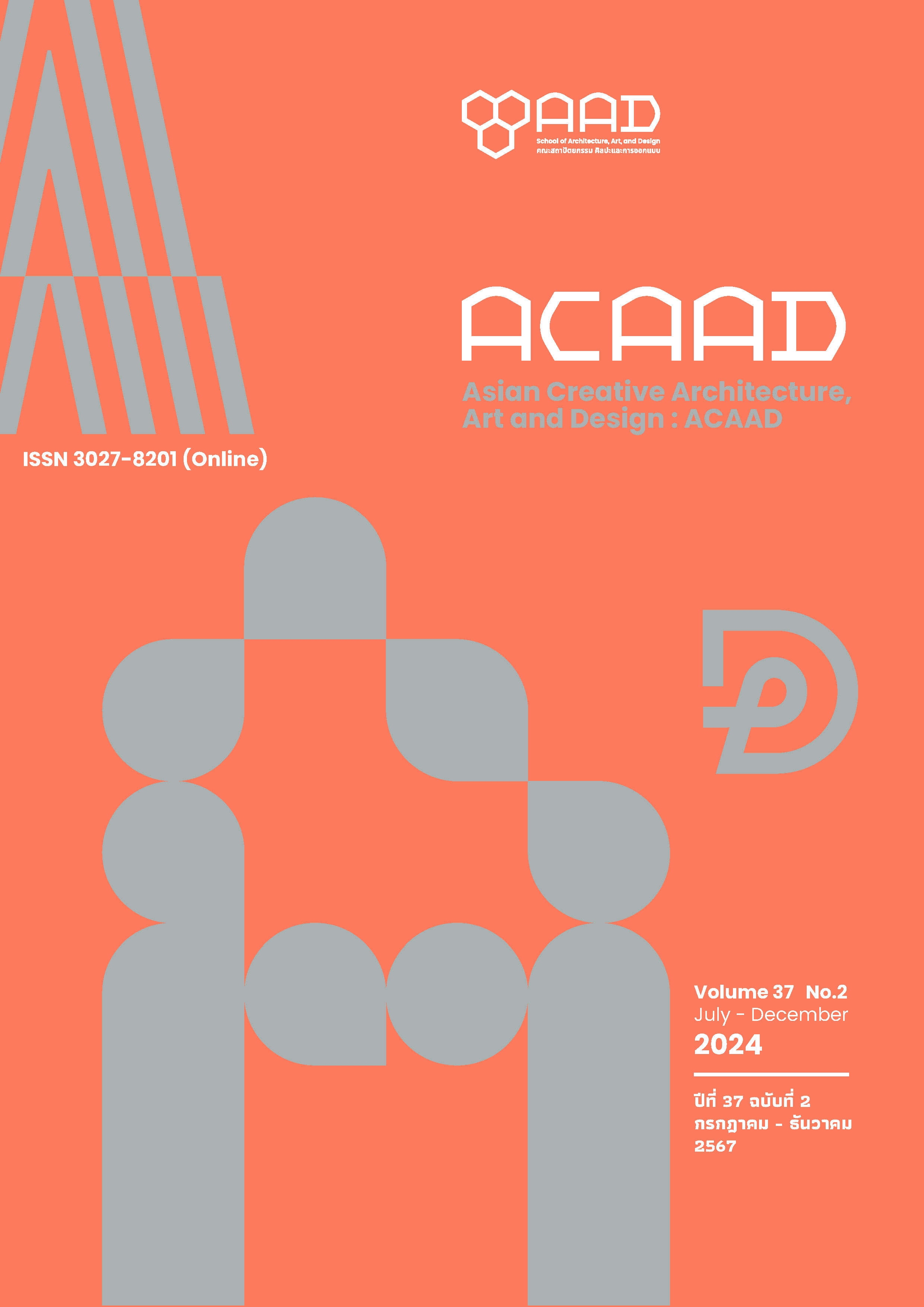Nostalgia in Shaping Place Branding: Pho Klang Street in Nakhon Ratchasima old town
Main Article Content
Abstract
This article aims to explore the value of identity from the potential of Pho Klang Street in the old town of Nakhon Ratchasima, in various dimensions that are connected to the people. This identity is built from the essence of the neighborhood towards creating place branding to drive creative neighborhood development through social participation. This research is qualitative, using a study method from field surveys combined with structured interviews. It evokes a sense of nostalgia linked with collective past experiences of people, reflecting relationships with and attachment to the place. The study involved interviews with informants using chain sampling, divided into three age groups: children and adolescents (ages 10-19), adults (ages 20-59), and elderly (ages 60 and above), with a total of 30 participants. Additionally, a physical survey and field data collection of the city using walking maps were conducted. The study results revealed both tangible and intangible cultural heritage, divided into two groups: 1) Lost cultural heritage that people still feel nostalgic about (3 sites), and 2) Remaining cultural heritage (18 sites), totaling 21 sites. In branding Pho Klang Street, the breakfast culture was chosen as the main image that people feel attached to and nostalgic about. This culture relates to the coffee house, a symbol of lifestyle and creative meeting places where generations converge, fostering deep relationships among the people in the neighborhood.
Article Details

This work is licensed under a Creative Commons Attribution-NonCommercial-NoDerivatives 4.0 International License.
This work is licensed under a Creative Commons Attribution-NonCommercial-ShareAlike 4.0 International License.
Copyright Transfer Statement
The copyright of this article is transferred to Journal of The Faculty of Architecture King Mongkut's Institute of Technology Ladkrabang with effect if and when the article is accepted for publication. The copyright transfer covers the exclusive right to reproduce and distribute the article, including reprints, translations, photographic reproductions, electronic form (offline, online) or any other reproductions of similar nature.
The author warrants that this contribution is original and that he/she has full power to make this grant. The author signs for and accepts responsibility for releasing this material on behalf of any and all co-authors.
References
Baker, B. (2019). Place branding for small cities, regions & downtowns. Creative Leap Books.
Boym, S. (2001). The future of nostalgia. Basic Books.
Chang, J. H. (2016). A genealogy of tropical architecture: Colonial networks, nature and technoscience. Routledge.
Chaiyaworaphon, A. (2002). From traditional coffee to Amphol Lampoon: Nostalgia in Thai society, nationalism or identity crisis. Sarakhadee, (March), 48-54. (in Thai)
Cheshmehzangi, A. (2014). Spatial syntagma and identity of a place: Sensing, relating to, and knowing a place. Journal of Human Behavior in the Social Environment, 24(7), 799-810. https://doi.org/10.1080/10911359.2013.876377
Committee on Documentation and Archives. (1999). Local history: The origins of important districts in the history of the eastern and northeastern regions. War Veterans Organization of Thailand Printing Press. (in Thai)
Kaefer, F. (2021). An insider's guide to place branding: Shaping the identity and reputation of cities, regions and countries. Springer.
Kitiasa, P. (2003). Anthropology and the study of nostalgia phenomena in contemporary Thai society. Princess Maha Chakri Sirindhorn Anthropology Centre (Public Organization). (in Thai)
Kotler, P. (2002). Marketing places. Simon and Schuster.
Kulpat, R., Dee-udomchan, J., & Hirunteeyakul, M. (2019). Nakhon Ratchasima: A study of the old town through history, settlement, and architectural heritage. Na Jua Journal, 16(1), 62-101. (in Thai)
MacCannell, D. (1973). Staged authenticity: Arrangements of social space in tourist settings. American Journal of Sociology, 79(3), 589-603. https://doi.org/10.1086/225585
McCarthy, J. (2018). Exploration of Siam (R. Maitrichayanan, Trans.). Matichon. (in Thai)
Nakhon Ratchasima Chamber of Commerce. (2000). 100 years of Korat trade: A historical retrospective. Future Press and Media. (in Thai)
Nora, P. (1989). Between memory and history: Les lieux de mémoire. Representations, 26(1989), 7-24. https://doi.org/10.2307/2928520
Shahabadi, M. R. Y., Sajadzadeh, H., & Rafieian, M. (2019). Developing a conceptual model for place branding: A review of theoretical literature. The Scientific Journal of NAZAR Research Center (Nrc) for Art, Architecture & Urbanism, 16(71), 19-34. https://shorturl.asia/2xXjP
Supamityothin, K. (2021). Conservation, rehabilitation, and development project of Nakhon Ratchasima old town commercial area as a historical tourist attraction. Nakhon Ratchasima Rajabhat University. (in Thai)
Torres, J. (2015, November 6). Taking a long-term view: The future of nation and place branding. Bloom Consulting. https://www.bloom-consulting.com/journal/taking-a-long-term-view-the-future-of-nation-and-place-branding/
Torres, J. F. (n.d.). Exclusive interview with country branding consultant Jose Filipe Torres. Nation Branding. https://nation-branding.info/2009/06/17/exclusive-interview-country-branding-consultant-jose-filipe-torres/
TPBO. (2015, May 21). Ares Kalandides on place management and urban planning. The Place Brand Observer. https://placebrandobserver.com/interview-ares-kalandides-inpolis-and-institute-of-place-management/


